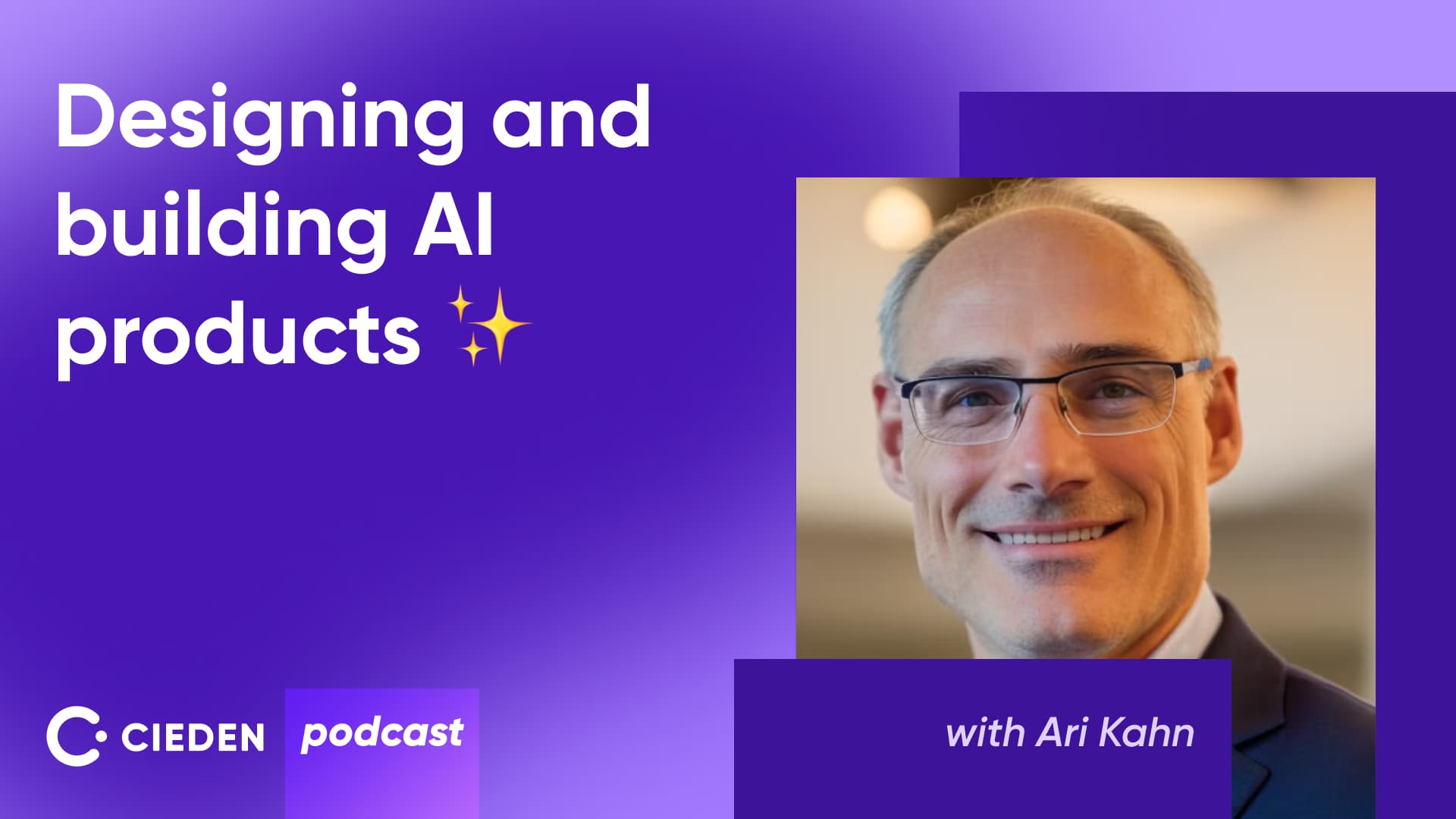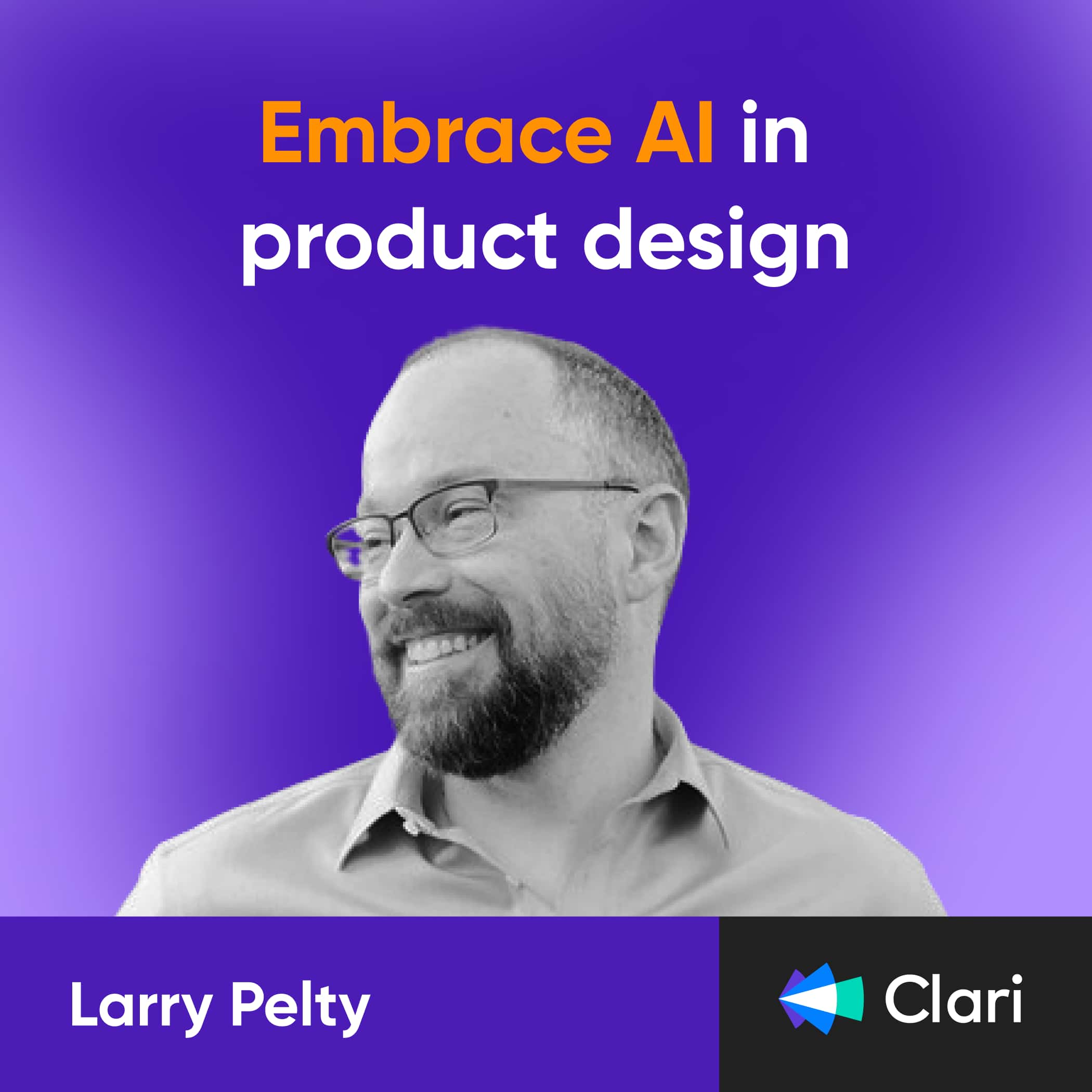Ari Kahn is 20 years in SaaS. He co-founded FatWire, which was later acquired by Oracle for $160 million. Under his leadership, FatWire expanded globally with offices in 13 countries and received top industry analyst ratings. Following this acquisition, Ari served as Chairman and CEO of resort development company Great Land Holdings, navigating it through the 2008 recession and transforming it into one of the region's most successful businesses.
Currently, Ari is a member of the Forbes Councils and hosts the eCommerce AI: The Revenue Revolution podcast. It’s one of the best podcasts about AI for businesses out there.
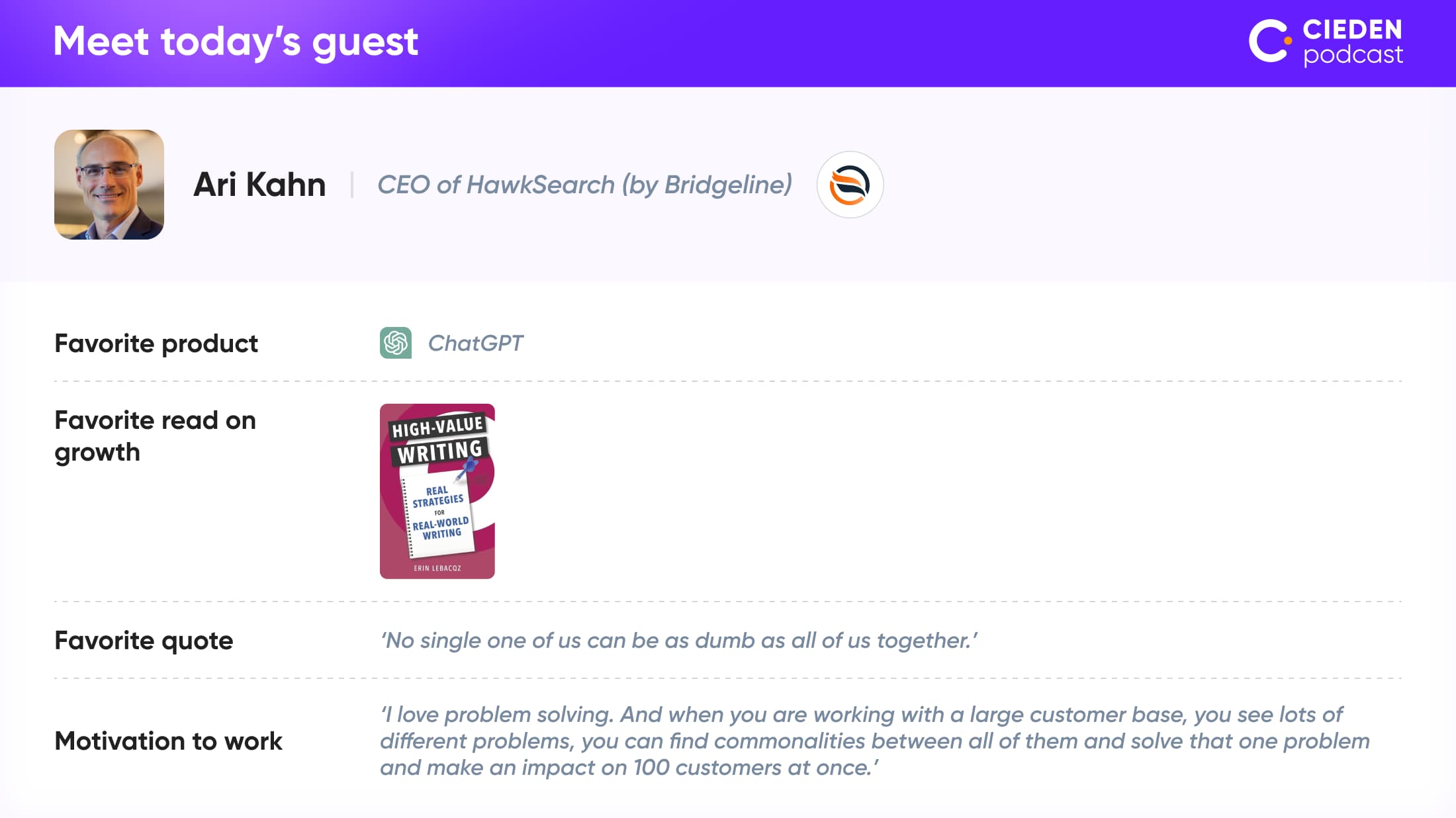
In this episode, Ari shares insights on AI trends and eCommerce disruptions, highlighting how Hawksearch uses advanced AI to improve online shopping search functionality.
Ari's background and journey into AI
Yuriy, Co-Founder and CEO of Cieden: Hello, Ari. Welcome to the podcast.
Ari, CEO of HawkSearch (by Bridgeline): Yuriy, thank you for having me today.
Yuriy: Ari, tell us a few words about yourself. What are you doing now?
Ari: So, my background is in computer science. Since I was 10 years old with a Timex Sinclair with 2K of memory, computer science has been my passion. That interest in mathematics also led me to a PhD in artificial intelligence. I started my first software company, FatWire, in 1996. It was one of the first marketing technology companies focused on content management. We sold it to Oracle, and after that, I worked on a few other projects, including venturing into real estate in the Caribbean for a while. I invested in and ultimately became the CEO of Bridgeline. I've been involved with AI since the nineties, and more has happened in the last 24 months than in the last 24 years. The playing field has been leveled, allowing small companies with great ideas to use AI as an infrastructure and release products in rapid succession tailored for their specific customers. That's exactly what we're doing. We're focused on improving our customers' online revenue by increasing their traffic, conversion rate, and average order value. Artificial intelligence, especially large language models and vector databases, allows us to release products very quickly. We just released Zeus, our latest smart search version, and it's receiving great responses and making an impact for our customers.
The value provided by HawkSearch
Yuriy: Tell us about HawkSearch. What’s the value of this product?
Ari: Smart Search can increase revenues by up to 22% for an online store. It does this because it has a few different core components. The first one is Concept Search, the second one is Image Search, and the third one is Generative AI. On the Concept Search side, unlike a traditional online store where you type the product that you're searching for, you can just type the goal that you have. For example, "I want to go hiking" or "I want to throw a party," and it will automatically make recommendations that help you achieve that goal. On the Image Search side, you're able to, for example, if you're working on a tractor engine, just pull out your cell phone, take a picture of the engine, and it will identify all the parts. If any of them happen to be broken, it will put those in your shopping cart, even if you don't know the name of that part in the first place. On the generative side, it can recognize when you have holes in your own product catalog, maybe certain products have outdated images or are missing images altogether, or don't have descriptions or are missing certain attributes, and it will automatically figure out what that image should be, what the description should be, and so forth, filling in those gaps so that your product catalog is more complete for a better user experience. None of that was really possible a year ago. We released this in Zeus just last week, and it's making an impact for companies as big as Hewlett Packard today.
Harnessing AI agents for B2C and B2B
Yuriy: What do you think about AI agents? Do you think they will also help with this kind of use case? Because one of the things we are experimenting a lot with is agents that can go online, search for missing data, and just provide you everything. One of the biggest problems for even eCommerce is finding information to fill in the database, to enrich it, and personalize it for users.
Ari: Agents are the next step in human-machine interfaces. Today, we're interacting with all sorts of websites directly, and there's a lot of actual human time and knowledge required to do something like go shopping. You have to know which sites to go to and so on. Instead, we're going to have custom agents that will know our different payment methods, coupons, which sites to find different products on, and they'll do the shopping for us. They'll be able to anticipate what we need so we don't need to tell them every time we want to go to the store. And there are going to be seller agents as well, creating a whole ecosystem between the sell-side agent and the buy-side agent. There will be actual social norms that develop on the internet. This is not 10 years out; this is actually happening today in the B2B space and will become very common in just a year or two.
Yuriy: So you think in the future, B2B agents will be negotiating terms together, like AI agents just exchanging emails on pricing, quantities, and quality, and then you just get an email that the contract is ready to be signed?
Ari: I 100% believe that is going to happen. You'll have negotiations happening on both sides. And what's interesting is that there will also be more sophisticated and bulk negotiations where your buyer agent will know that, okay, I need this now, but I'm going to need something else in the future, and can negotiate bundles of purchases, timings for deliveries, and so forth. It would be too sophisticated for us as individuals to negotiate. The sell-side agent will do the same thing, and all of that will tie into inventory on the sell side. They will have predictive analytics to provide even better inventory management, becoming critical for just-in-time delivery with last-mile inventory and micro warehouses. The only way to pull that off is with sell-side agents.
Ecommerce risks and strategies in the age of AI
Yuriy: Ari, you mentioned that these kinds of agents will be able to do shopping on different websites. Is it a risk for lots of eCommerce founders that some big players like Google could build a product that will just eliminate all eCommerce websites, or like Amazon, and just, if it's not on their website, they will buy it for you somewhere else?
Ari: It is going to be a risk. Between now and then, there are a couple of things we need to be aware of. First, your site itself needs to be agent-friendly. The easiest way to do that is to follow accessibility guidelines like the American Disability Act and ensure that you have the appropriate metadata with schema.org and annotations for images, so that a blind person could access your site. That will allow Google to index it better, so today you'll have better SEO, but also enable agents to more easily navigate your site. Ultimately, you do have the risk of things consolidating, and this is not unrelated to what's happened in the D2C (direct to consumer) area, where B2B businesses are bypassing distributors and selling directly to their endpoints rather than indirectly through a distributor. If you have a mega sales agent like Amazon and everyone becomes D2C, then we as individuals need to start thinking in terms of where we want to work. You really want to work at the beginning of the chain, on the manufacturing side, rather than in the middleman part, which could become automated and potentially consolidated with a few major players.
Future of search engine optimization with AI integration
Yuriy: That's interesting. What changes do you see for search engine optimization? Because I think it's also huge. There is a lot of dynamically generated content. In one of your podcasts, you mentioned that one of your products focuses on generating pages. Do you think that in the future, we will mostly be using interfaces like Perplexity or ChatGPT to generate websites for us? I know that at the beginning, you started with your own CMS system, and it's like a natural evolution of the CMS system. But now you're not just providing the content; you can provide databases, information, and prompts, and it will generate the content that's super personalized for a person. Maybe they won't even need to visit the website.
Ari: Companies will have to think more about their business terms, competitive advantage, and target audience. The site will be largely generated for them, or the site won't exist at all. There will just be RESTful APIs or some lower-level access to that information that an agent is browsing and shopping for automatically. The more creative part, and this can be automated with AI because everything intellectual can be automated, will be deciding which products to release, how they will be presented, what the total addressable market is, and the ideal customer profile. Those business concepts, pricing, and bundling will be more critical. Building the website will become less creative and more automated.
Cultivating innovation
Yuriy: You are definitely in an area of very fast innovation. How do you work with your team to ensure they are on the edge of this innovation and not missing opportunities? From what I see in the market in general, with the people I talk to and clients, mostly everyone wants what's already available in other products or something very similar. Like, we need a chatbot to integrate into our system or we need to generate emails from prompts. But the vision for something new is mostly limited for most teams, or they are not willing to take the risk and are waiting for guidelines, like material design guidelines for Android many years ago, on how to use AI in their products. In this time of innovation, it's crucial to be on the edge and test new ideas first that can open huge opportunities. How do you do it with your team?
Ari: You can't be feature-chasing your competition. If you think about product management, it needs to listen to customers, competitors, your own engineering team, and your sales team about what will win deals, but it also needs to abstract everything it hears to find out what the real core need is and consolidate all of that. Tomorrow morning, we have an internal meeting at Bridgeline where I'm going to announce a contest. Every single department, even finance, support, and engineering, will have their own copy of Smart Search and, on a department level, a contest to come up with the best use case and aspirational use case more than what we can do right now, and to create the best demo. Why are we doing this? Because you don't know where a really interesting idea is going to come from. Our finance team, who are in more administrative roles, may come up with the best use case that we need to build. You have to listen to everybody, especially those not in the specific domain you're developing in, because those people are stuck in a mindset, feature-chasing, and getting caught in the weeds. They are doing critical stuff, but it's very difficult for anyone to innovate when they're that close to the subject.
Yuriy: I totally agree with you. I have my own experience from when I worked as a UX designer with a team. Most of the ideas came from backend developers about the user interface. It was crazy because I am a UX designer, but that showed me that everyone in the team can provide great ideas, and it's very silly to limit them to their role and say, "No, you are just about backend code that nobody sees."
Ari: With AI, because we have programmed ourselves to interact with machines in ways that machines can understand, often subconsciously, you almost need to go to children and ask them to play around with things and see what they do because they're not brainwashed into limiting their behavior to keyboard and text.
Yuriy: When we gain more experience, we become aware of so many limitations. I also see it in my management style. When people come to me with ideas, they say, "We tried this. It didn't work." But you have to be open because new technology provides new opportunities. Maybe what didn't work years ago will work now.
Challenges in human-machine interaction
Ari: In terms of AI and what is often called multimodal in AI, not just images but video, sound, and maybe ultimately even smell can all come into the equation in the human-machine interface. We have people with 25 years of human-machine study, and they are still focused on reducing the number of mouse clicks. It's like, forget about mouse clicks. You're going to have a camera that you're interacting with in a real-time way. It would be very difficult for someone with 25 years of experience in reducing mouse clicks to rethink human-machine interaction.
Yuriy: The main challenge now in the era of AI is that it's a mix of technology push and user research. We have the technology, and we need to find new ways to use it and solve problems. Usually, for product development, we check what people need, identify the pains, and then look for technologies to solve those problems. Now, new technology can change all the problems people have. In eCommerce, you could target traffic acquisition, how people search for products, reporting, and insights. If there is a human doing the job, AI can usually help improve it.
Ari: When I was doing my PhD thesis in computer vision, I focused on attention. We had a robot that used hand gestures to interact, pointing to objects for the robot to pick up. We didn't have enough computing power to process all the information, so we needed to reduce it. My thesis was about negative attention: finding all the boring stuff in the scene—the white wall, the sky, the floor—and removing it, then processing what remained with a positive attention mechanism. Interacting in real time with vision, with a cell phone or goggles, and processing what matters to that individual with an attention mechanism is an open area with huge potential. We need such innovations for everything from self-driving cars to robots in shopping stores.
Building an innovative product team
Yuriy: How do you build your team to be innovative? Do you hire smart people and help them build a visionary approach and develop new skills, or do you hire people with the skills you need?
Ari: We like to build skills internally. You need senior people sometimes, but straight out of college, 22-23-year-olds working with a senior engineer is a great mix. If I don't have HR problems, then we're doing something wrong, which means having young people that goof around sometimes. Though I've spent a lot of time in university, I don't believe that looking for a PhD and years of experience at IBM is the best way to find the most skilled and innovative people. We prefer young people, agile teams, and short sprint development cycles. We must be ready to throw away a project if it's going in the wrong direction. If you have a team that can be objective, that's how you succeed.
Balancing UX design and engineering

Yuriy: Your projects are very focused on user interaction and user experience. How do you approach user research and build a successful team for great user experiences?
Ari: You must test your software with inexperienced users and think about user experience from day one. If you don't, you'll end up in a corner. Find people similar to your end users who are inexperienced and take their mistakes seriously. Simplifying things is hard but necessary. You're not a hero if you make something super complicated; you're a hero if you make something simple and effective.
Yuriy: You have a computer science background but understand the importance of design. Developers usually prioritize complexity and innovation, while design and usability are secondary. How do you balance that?
Ari: It's a cultural problem in engineering. If you can't walk away from the code and have someone else pick it up, the code is too complex and needs simplification. Consistency in the API, intuitiveness of method names, and objects need to be well thought through. If you truly understand the abstractions, it will be easy to use. When interacting with the real world, think about what is intuitive to the end user and their normal experience.
CEO's role in design decisions
Yuriy: Are you still involved in design decisions? Some CEOs are heavily involved, while others delegate completely. What is your approach?
Ari: You have to be careful not to dominate the room. As a CEO, if you blurt out an idea, everyone thinks they must do it. I love design and want to be involved, but I also know that if I just show up in the middle of the process, it’s not functional. I provide high-level direction at the beginning stages and mentor on keeping an open mind, then get out of the way and let the team do great things.
Yuriy: How big is your design team?
Ari: We have eight people in design, then engineers, and a services team implementing the products the engineering team creates. This feedback loop is crucial because if our customers have to spend a lot of money to go live with one of our products, that's money they could have used to make their site more successful, benefiting us too. We aim to reduce that cost and listen carefully to how long and difficult it is to implement our software.
Yuriy: Do you provide customizations for each client?
Ari: Customizations come from the services team. We recently released our rapid UI feature, taking most of the 2022 customizations and making them out of the box. Moving from customization to configuration changes our mindset, focusing on adding value after going live, becoming more strategic consultants, and thinking about real strategy rather than just engineering.
Business model and Customer Acquisition Cost
Ari: In SaaS, a major challenge is customer acquisition cost relative to both the lifetime value and the cash flow of the software sold. We aim to reduce customer acquisition costs by increasing the total addressable market and better differentiating against core competitors. Making the most valuable features out of the box is a great way to reduce customer acquisition cost, providing value from day one.
Yuriy: Regarding the portfolio of products, some build one product and focus on it, while you have a portfolio. How did you decide this strategy?
Ari: Our business model aims to reduce customer acquisition costs while increasing our customers' revenue. By having multiple products, we only need one customer acquisition cost, then we can sell additional products to that customer without additional marketing spend. We created eCommerce 360, a dashboard with AI that analyzes our customers' needs and recommends other products we offer, helping us expand our revenue per customer.
Approach to system redesign
Yuriy: You mentioned launching a new version of your system. How did you approach the redesign and launch? Gradual change or a completely new version?
Ari: We do both, but this instance was a gradual change. This includes incremental feature sets and pricing. For Zeus for Smart Search, the pricing is 30% of what the pricing was for Hawk Search. This way, we don't have to renegotiate with customers, and all features are enabled by paying for the license, turning them on out of the box. Depending on the value proposition, we may take an incremental or a non-incremental approach.
Pace of innovation and releases
Yuriy: What is the correct pace of innovation? Some companies release new features almost every week, often creating bugs. What do you think?
Ari: Releasing every week is usually too much. Incremental releases can slide in, but major features that impact stability or are apparent on the user dashboard should be quarterly. Small updates could be monthly, but too frequent changes can jeopardize reliability and confuse customers. In today's environment, at least quarterly updates are necessary to show continued investment in the product.
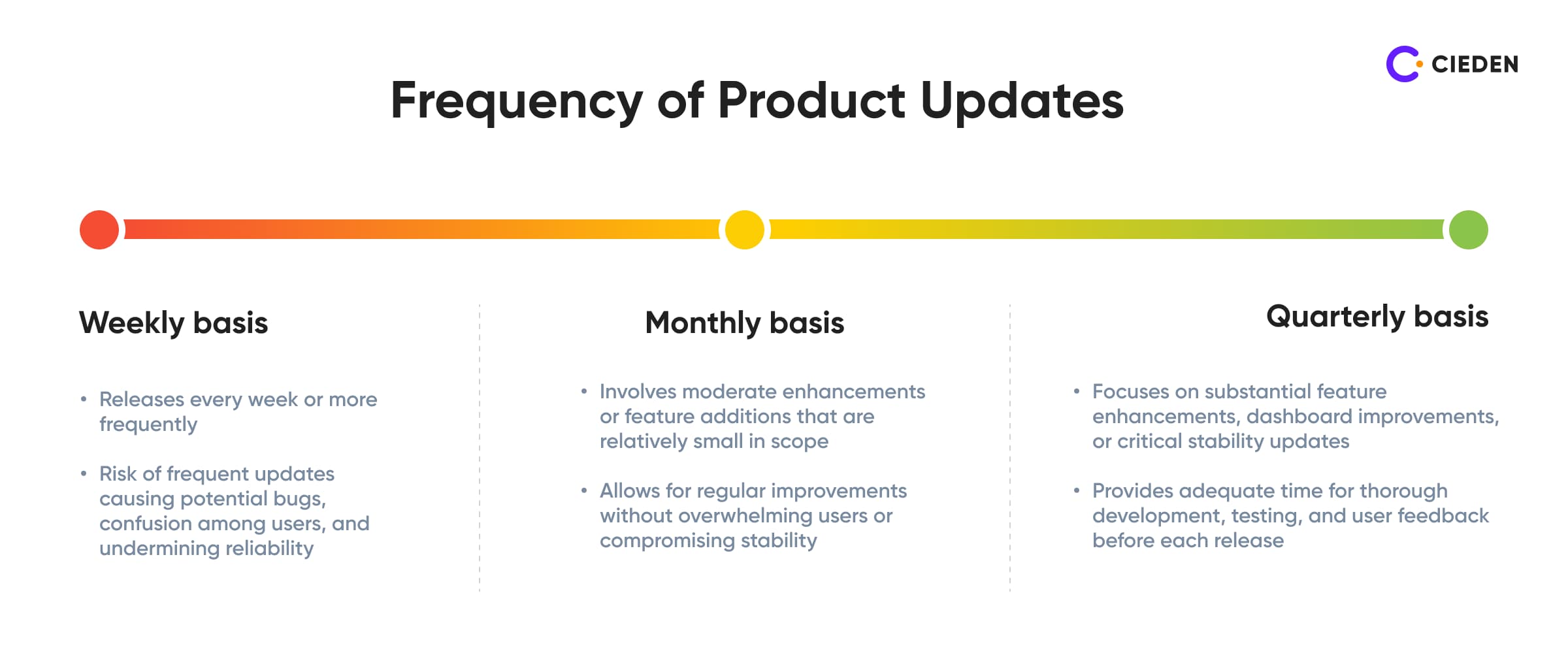
Adaptability of roadmaps
Yuriy: Do you believe in roadmaps? Should companies listen to the market daily and react quickly?
Ari: I believe in roadmaps but also in being ready to tear them up. You need a vision and a compass to keep moving in the right direction, with different resolutions. At Bridgeline, our top-level roadmap focuses on generating online revenue for our customers, with three categories: increasing traffic, conversion rates, and average order value. Specific feature deadlines are important, but flexibility is also needed. If you're not bold and can't change direction when necessary, you risk failure.
Yuriy: Have you ever had to say no to feature requests from clients because it would change the product too much?
Ari: For startup entrepreneurs, a best practice is to win a few customers with consulting and then turn common needs into a product. However, when major customers ask for features, you sometimes can't just lose them. Building a strategic relationship with higher-level executives helps them understand your long-term vision. Sometimes, you'll have to make concessions, but having executive-level relationships allows for some latitude.
Today, if you're not bold and can't throw away a product or a roadmap and say that someone passed us and we gotta catch up over in this direction now, you're gonna end up going off a cliff 👇
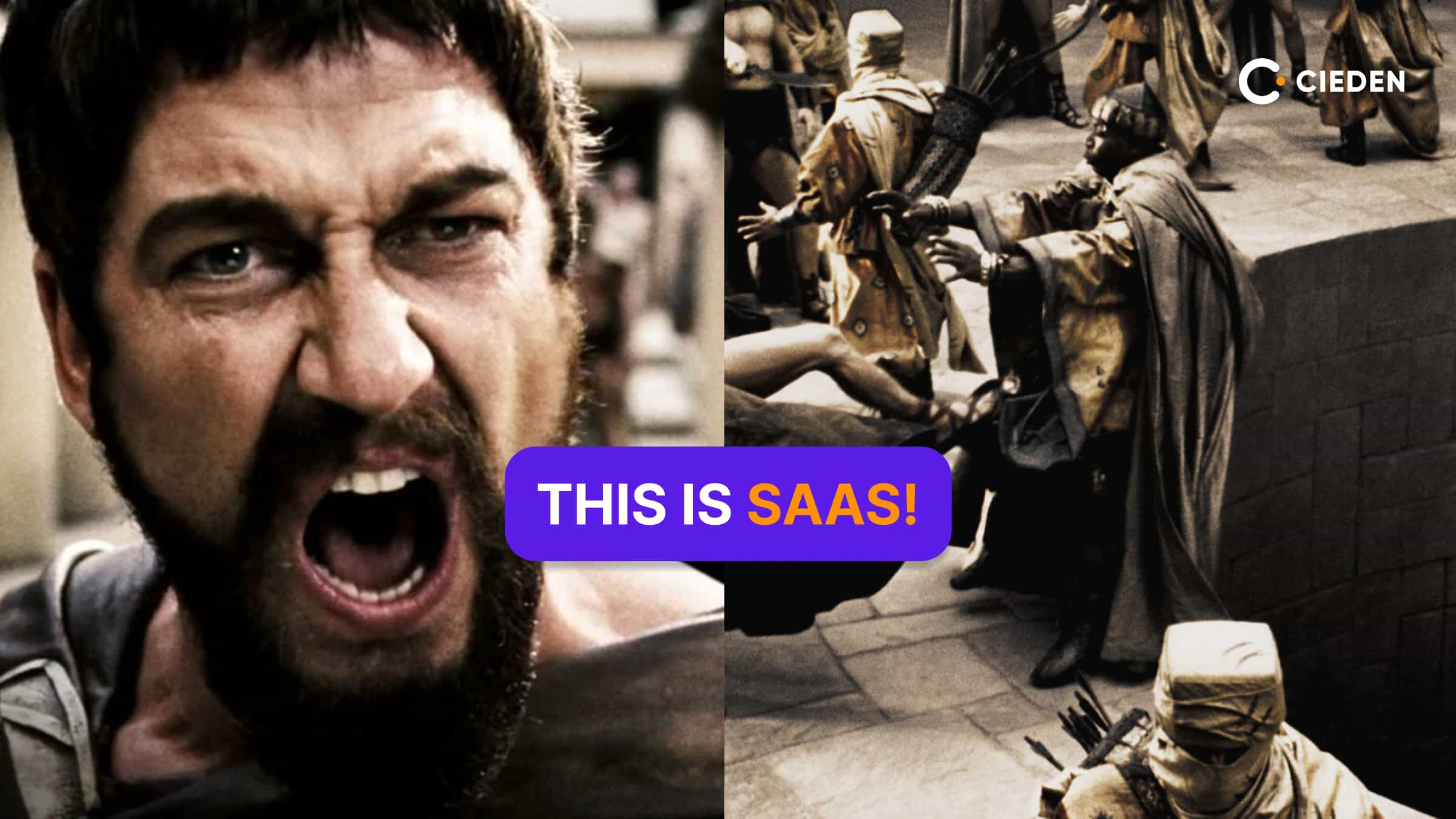
B2B vs. B2C development approaches
Yuriy: From your experience regarding product development, process research, what are the main differences between B2B development and B2C development? Because in B2C, usually you have to listen to users, but there is no way one user will tell you what to do, you decide. But in B2B, as you mentioned, there are some cases when you still have to listen. How do you work with this kind of, what's the difference?
Ari: Yeah, yeah, well in the B2B world you are actually speaking to a smaller number of customers that have a more structured set of needs and it's a lot easier to build a spec sheet and look for similarities that's actually a lot easier on the B2C side you almost end up in a world of statistical analysis where you have to do a lot of multivariate testing. You've got to look at a lot of use cases. You have to search for the inexperienced user and really watch them carefully. It's actually a very different skill set and you have to be much more open minded in the B2C world. It's dangerous in the B2C world, cause you can also if you know, you're not going to have enough time or money to evaluate thousands of users unless you're Apple, right? So you could end up being stuck in a cohort, not noticing it and find yourself off in the wrong direction. B2C is harder in a lot of ways. People think it's easier because I can relate with it and so forth, but there's a lot of wrong directions that can be followed and some luck will have to be found in order to survive some.
Yuriy: Yeah, I heard that for many people it's more boring because business processes, deliveries, logistics, it's not fun. And everybody wants to build a new social media platform or new products that all their neighbors will use. And in this case, maybe it's a vanity metric for people, but they want to build something that everybody uses. But ideally the most problems, unsolved problems are still in the area of business.
Ari: Right, just imagine Facebook, right? So you've got hundreds of social media platforms at that time. And so there's a lot of luck that Facebook ended up being the one who would have guessed that by just having a like button rather than two or three different ways to react that that was the way to build subscribers. Incredibly difficult to analyze that. And you have to have the depth to fail and walk away from whatever, Facebook 1 .0 and try FacePoint 2 .0, because if you've got all of your eggs in one basket, that's a tricky bet.
Yuriy: Yeah, thanks. I think it's a super interesting chat. Maybe you want to touch on some other topics or because we are almost out of our time.
Ari: Well, I think that one of the topics that everyone needs to really watch for is different use cases for multimodal large language models. This is a technology that is available for everybody. Hugging face is a great marketplace, so to say, to be able to grab access to the different language models and to just play, just play. You don't need to be a hardcore engineer with what the different capabilities are. What if I'm looking for matches to an image? What if I'm describing an image and find and want to create other images that are similar to my description and so forth? I have no idea what the great products are that are going to come out of it. No one does, but it's going to come from somebody that you don't expect. It's going to be just somebody goofing around and then they invest some more time and turn it into a product. It's an exciting area.
Yuriy: Thank you. It was a nice hour spent together. I think we covered many questions, many topics regarding building teams to the future of AI and how wonderful are our prospects for the future and how many new products could be built. Thank you for sharing your insights. It was very valuable and it's super cool to see the person who is so savvy in technology, in business and user experience and other stuff. I think that's because you have been in the industry for many years from dot -com bubble times, I guess, but also because you're still curious and you still enjoy what you're doing. And that's a pleasure talking with people who enjoy what they're doing.
Ari: Well, thank you, Yuriy. The pleasure has really been mine. This has been fantastic.
That’s all for this time. If you think your colleague or friend could benefit from these tips, please share this episode with them. Thanks!


